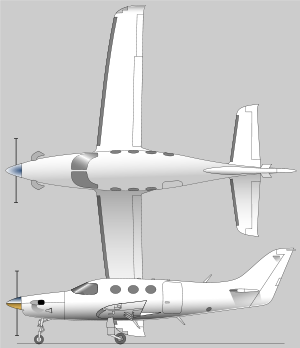Kestrel K-350
| Kestrel K-350 POC | |||||||||||||||||||||||
|---|---|---|---|---|---|---|---|---|---|---|---|---|---|---|---|---|---|---|---|---|---|---|---|
 | |||||||||||||||||||||||
| Kestrel K-350 POC | |||||||||||||||||||||||
| Role | single engine turboprop | ||||||||||||||||||||||
| Manufacturer | Kestrel Aircraft Company | ||||||||||||||||||||||
| First flight | 29 July 2006 | ||||||||||||||||||||||
| Number built | 1 proof-of-concept | ||||||||||||||||||||||
| Unit cost |
USD$3.2 million (projected)[1] | ||||||||||||||||||||||
|
|} The Kestrel K-350 or Kestrel (previously the Kestrel JP10) is a high-performance single turboprop-engined all-composite six-seat aircraft.[2][3] The proof-of-concept (POC) first flew on 29 July 2006.[4] and by April 2010, registered N352F, had logged about 260 hours.[5] Its layout is low-wing with a conventional tail. The tricycle undercarriage is fully retractable. Its construction uses composites incorporating carbon fiber. The engine that has been powering the POC is a Pratt & Whitney PT6-67A turboprop flat rated to 1,000 hp (746 kW).[2] In 2011 the company selected the Honeywell TPE331-14GR engine as first choice for the aircraft, also flat rated to approximately 1,000 hp (746 kW).[6] The company, formed in 2002 to build the aircraft, was started by Richard Noble who was responsible for the team that first broke the sound barrier on land. Noble envisioned the aircraft's primary role as being part of the fleet of “air taxis” flying over Europe that provide an alternative to both commercial airlines and chartered corporate jets. Noble named his Farnborough, England based company “Farnborough Aircraft” and the design for the then designated “F1” was detailed.[7] The name of the company was later changed to Kestrel Aircraft Company and the aircraft’s designation was changed from “F1”, to “JP100”,[8] to “JP10”, and is now the "K-350". In April 2015 the company was merged with Eclipse Aerospace to form One Aviation.[9] DesignThe carbon-fiber composite construction is claimed to allow a lower drag shape than does all-metal construction. The wing is also of carbon-fiber construction and features a high lift laminar flow design worked out mostly by aerodynamicist Dr. Gordon Robinson.[10] The cabin features a club-seating arrangement, a toilet (or a possible seventh seat), and a baggage compartment in the pressurized area. In the cockpit, side window pillars are eliminated for a more unobstructed view for the pilot.[11] Farnborough Aircraft formed a business alliance with Epic Aircraft to develop both companies' aircraft and as a result the POC aircraft appears similar to the Epic LT. The wing is reportedly the same, while the Kestrel’s fuselage is 20 inches longer than the Epic’s. The fuselage is also slightly wider and has a 27% greater interior volume.[12] The window and door arrangement on the left side of the aircraft is noticeably different. DevelopmentA business partnership formed in 2006 to complete the Kestrel’s development, named the Gulf Aircraft Partnership and located in the UAE, did not proceed.[8] In 2009 Kestrel Aircraft’s Adrian Norris reported that the company was ready to freeze the design and build conformal prototypes as part of the effort to seek FAR Part 23 certification.[13] A business relationship has been formed with Liberty Aerospace of Melbourne, Florida, United States to provide assistance with Toray carbon fiber components.[5] In 2010, Alan Klapmeier, co-founder of Cirrus Aircraft Corporation, joined with Anthony Galley and others in the renamed Kestrel Aircraft Company.[14] The wing is to be redesigned to improve stall characteristics and ease of construction, most likely eliminating the wing’s planform elliptical leading edge.[14] On 23 July 2010 Kestrel Aircraft announced that they will be relocating to large, relatively newly built hangars at the soon-to-be-closed Brunswick Naval Air Station in Brunswick, Maine. The company will receive some local financial assistance in exchange for an anticipated eventual creation of some 300 jobs. On January 17, 2012, it was announced that the aircraft will be produced in Superior, Wisconsin due to tax incentives totalling US$50 million, and that a smaller workforce would remain in Brunswick creating composite components for the aircraft.[15] In July 2013 it was announced that the aircraft would be equipped with the Garmin G3000 avionics suite. Kestrel CEO Alan Klapmeier also stated that funding delays had slowed progress on the aircraft and that a conforming prototype was now expected to be ready in the summer of 2014, with the first customer delivery forecast for the end of 2015 or early 2016. Type certification costs were estimated at US$175M, with US$50M already spent.[16] By September 2013 employees were reporting that the company was short of money and that salaries and insurance payments were missing or late, and that vendors had not been paid. The company indicated that development had been delayed due to lack of investment and that the first flight of a production aircraft would not occur in 2014.[17] In early 2014 it was reported that Kestrel Aircraft had fallen months behind on loan payments to the Wisconsin Economic Development Corporation due to financing delays. It was also reported that the delay in financing had impacted hiring, causing the company to reduce its staff in Superior. The WEDC and Kestrel have agreed upon new terms that will defer the payments until November 2014.[18][19] As of July 2014, some finance had come in and employment grew at its Brunswick Landing facility, but the total amount of $100 million had not been reached.[20] Specifications (Kestrel K-350)Data from manufacturer[21] General characteristics
Performance
See also
References
External links
| |||||||||||||||||||||||